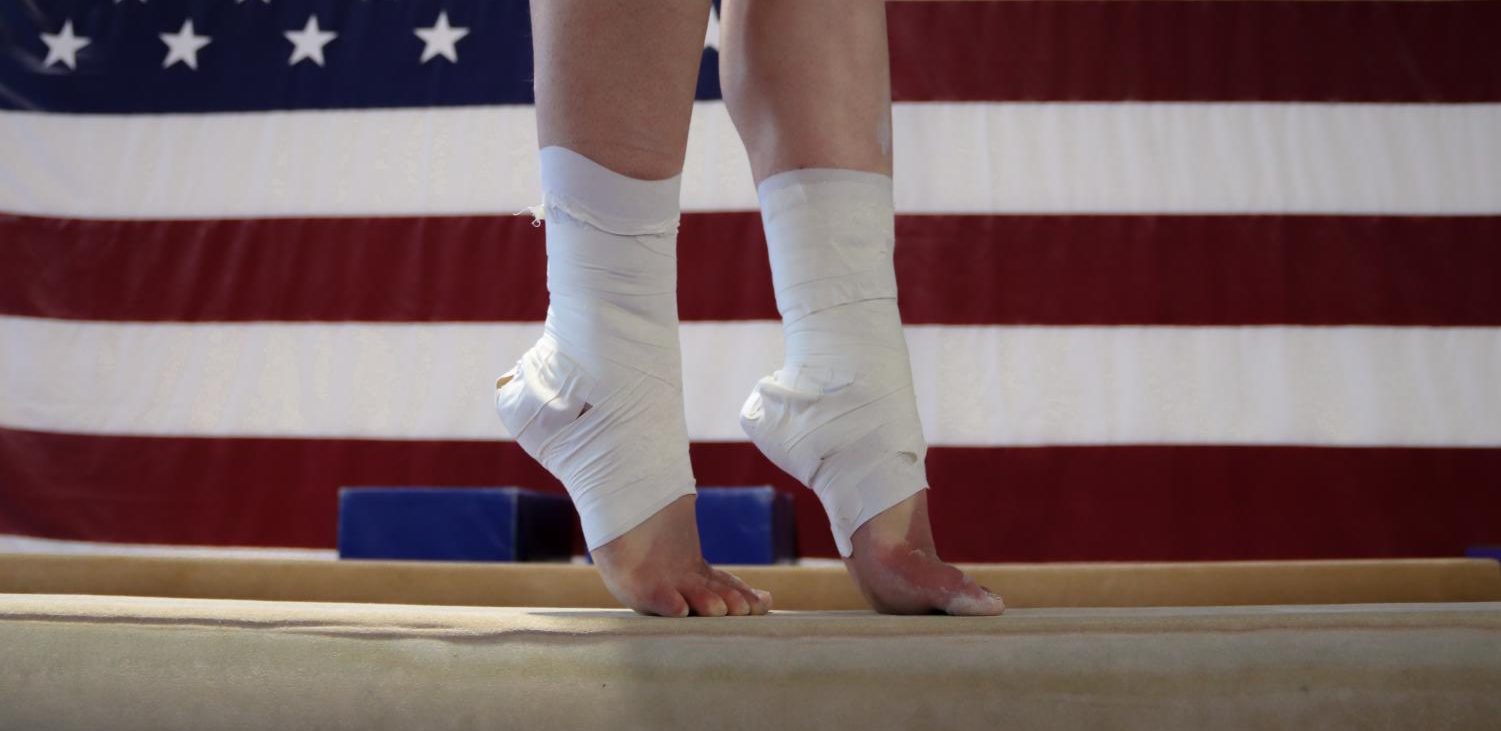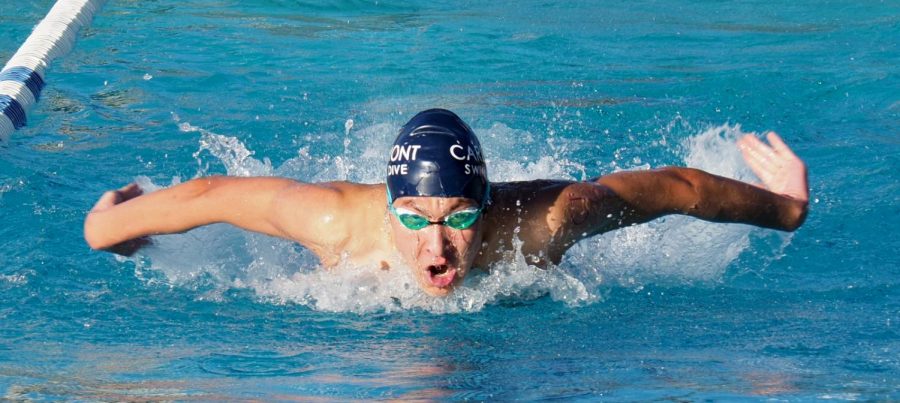Juliette Jaques watched her TV in raptures. A rerun of the 1996 Olympics was playing on the screen. An aspiring gymnast herself, she looked in awe at the beautiful floor routines, nail-biting beam skills, and high-flying bar releases.
And then came the vault, the moment she had been waiting for. She watched Dominique Moceanu sprint across the runway and push herself off the vaulting horse into the air. But instead of a perfect landing, she crashed hard onto the mat. After her second vault ended in another fall, the lively American crowd gasped. The gold medal that seemed so sure a few moments ago seemed to fade away. Then came Kerri Strug.
After falling on her first vault, it was clear Strug was severely hurt. She limped back down the runway, barely able to put weight on her ankle. Jaques leaned forward in her seat as she watched Strug glance at her coach Bella Karolyi, who nodded at her.
“Shake it off. You can do it,” Karolyi said.
Strug took a deep breath, steadied herself, took off down the runway, and delivered a spectacular vault that landed on one foot to clinch the gold medal for the United States.
With that feat, Strug solidified herself as one of America’s Olympic heroes. Worshipped for her bravery and toughness, she became an inspiration to many little girls across the country, including Jaques.
“She was one of my childhood heroes,” Jaques said. “But upon reflection, the memory, like many of the ones associated with watching the Olympics as a child, is tainted. It hurts to know what those girls were going through.”
Jaques has been involved in gymnastics since she was a young girl and holds a fierce love for the sport. She worked her way up to becoming a level 10 gymnast and quickly developed a reputation for her hard work, supportive attitude, and toughness.
“Juliette is definitely the teammate who works the hardest and endures the most,” said Skye Evans, a teammate of Jaques. “Her integrity is just incredible, and she never quits, even when you can tell she’s in pain.”
But Jaques’ admirable qualities led her to work past the boundaries of safe and healthy athletic performance, sending her on an arduous road of surgery and long-lasting discomfort.
“Most of my injuries have started as overuse injuries, like stress edemas, stress fractures, and tears that developed into bigger issues due to my lack of acknowledging and resting when I felt pain,” Jaques said.
Jaques felt it every time she put weight on it — a stabbing pain in her arm. At first, it was tolerable; she could still perform her routines without difficulty. It’s fine, she thought. I don’t need to tell my coaches. It’s better to say nothing and tough it out.
However, it soon grew worse. She could barely push on it without wincing in pain. Rolls and rolls of tape were used for braces that did little to provide relief. Despite this, she still kept going, spending roughly 20 hours in the gym each week. This refusal to acknowledge injury resulted in a host of setbacks and surgeries. And it was becoming a pattern.
“I have done this time and time again, ignoring the pain and just hoping it goes away tomorrow, or telling myself ‘it’s not that bad, it’s just sore,’” Jaques said. “Almost every time I have ignored a serious pain, it has developed into a much bigger injury.”
A widespread issue
Jaques is not alone in her desire to continue to train through injuries. Over the years, she has watched numerous other gymnasts struggle silently with pain, often resulting in worse injuries slower recoveries. In her mind, a lot of this has to do with fear.
“The main reason a lot of gymnasts don’t tell their coaches about what hurts is fear. Whether that be fear that they won’t believe what they say, that they will think of them differently, or view them as less than others. It might even be the fear that coaches will tell them to stop, because that is also something gymnasts hate hearing.”
This is common in other sports as well. Andrew Ghazhouli is a runner for Carlmont’s varsity cross country and track teams. Though he has completed numerous successful athletic seasons, Ghazhouli suffers from shin splints and underwent surgery for his femoroacetabular impingement (FAI), a condition that likely stems from acquired overuse where an extra bone grows along one or both of the bones that form the hip joint, causing painful friction.
Despite the incredible pain from the injury, Ghazouli continued to run.
“I remember when Andrew’s hip was really bothering him,” said Jack Peacock, a fellow runner and teammate of Ghazouli’s. “He still kept running. Once, he ran 16 miles with that injury.”
After having surgery, Ghazouli has recognized the importance of resting or limiting his workouts when injured. However, he feels many athletes make the mistake of continuing through injuries.
“I think all athletes who get injured want to push through it at first. It took me a while to learn that it was ok to take breaks,” Ghazouli said.
These mentalities are not unique. Pushing through pain is a normalized part of almost every sport. Many athletes will let their pain take the back seat due to the desire to compete and the deep institutionalized belief that ignoring injuries demonstrates a quality of toughness celebrated in athletics.
“Dealing with pain is definitely a large part of the culture of sports,” said Alyssa Herrera-Set, a physical therapist and founder of On the Move Physical Therapy and Pilates. “There are a lot of interesting sayings that convince people to do so, like ‘no pain no gain,’ or ‘pain is weakness leaving your body.’ That is something that’s kind of beautiful… pushing through a little bit of pain, either mental or physical. But there needs to be a balance.”
Tipping the balance
For many athletes, this balance is challenging to find. What at first may seem like a minor annoyance can quickly turn into problems that further impact performance and lead to more severe injuries. Admitting that conditions are worsening and taking a step back can be extremely difficult.
“I definitely notice teammates pushing through injuries,” said Billy Picht, a Carlmont swimmer committed to the UCSB swim team. “The expectation is that you’re at practice every day, and the fact that injuries take you away from the pool makes ignoring them way too common. It’s super easy to avoid any change and keep swimming like nothing’s wrong, but the more you keep going, the worse your injury gets.”
Being a high-level athlete, Picht is surrounded by athletes with dreams of competing at the collegiate level. These dreams and the desire to compete have caused some of his teammates to push through injuries to unhealthy levels.
“A friend of mine who graduated last year had a shoulder injury when she was young, and she tried to swim through it,” Picht said. “She ended up needing surgery, and even after that, her shoulder was still bothering her years later.”
In the past, Picht struggled with chronic shoulder pain due to overuse while swimming. After going to the doctor, he discovered he was suffering from inflamed ligaments.
“I noticed that my shoulder started to hurt for each stroke I took,” Picht said. “It kept getting worse, so after a couple of days, I went to an orthopedic doctor, and he said that the ligaments in my shoulder had gotten inflamed.”
Picht realized he needed to stop the injury’s progression before it was too late and took steps to prevent his condition from worsening. He communicated the issue with his coaches and came up with a plan to heal and come back stronger.
“The first thing I did was stop swimming. I went to practice, but I kicked the workout instead of fully swimming,” Picht said.
Picht has no regrets about his decision and believes it to be the best choice for athlete health and safety. However, he realizes that the choice he made can be incredibly difficult for others.
“I felt comfortable communicating to my coach about it, but I was definitely lucky,” Picht said. “There were no big meets coming up, so there was less pressure to come to practice every day, and my coach and I know each other very well, which made it much easier to talk to him. Not every athlete has that circumstance.”
For some athletes, their sport can foster a culture of competition, fear, and intimidation that prevents them from speaking out about their pain. Kaitlyn Fong, a former gymnast, dealt with this kind of environment and saw firsthand the negative consequences that followed.
“I did not feel like I could communicate with my coach about any pain. I was afraid, so pushing through it was the general practice.” Fong said. “My coaches invalidated [my team’s] feelings, strictly regulated our outward emotions, and utilized punishment to cultivate an anxious and fearful atmosphere. It was easier to push through rather than deal with the anxiety and emotional drain that came with trying to communicate.”
Communication is key
In too many cases, a disconnect between coaches, parents, and athletes can foster an immense amount of pressure to perform and a lack of desire to communicate.
“Pressure is a huge factor that drives athletes to push through the pain to the point where it becomes detrimental to performance,” said Herrera-Set. “Athletes can face all kinds of pressure — pressure to please their coaches, teammates, and parents, and in addition, the pressure they put on themselves to achieve athletic goals like playing pro, getting onto a college team, or even just keeping up with their friends.”
To Herrera-Set, creating a healthy environment with good relationships is the best way to combat these pressures.
“If I could change anything about the culture of sports, it would be to improve communication between all people that are supporting the athlete,” Herrera-Set said. “All sports should push a culture of open communication and support between all parties invested in the athlete.”
A desire for helping prevent injuries and foster positive environments for athletes led her to co-found GymSAFE, a nonprofit dedicated to providing athletes and coaches with tools to combat injuries and promote mental and physical care in the sport.
“I would see recurring patterns and injuries in athletes, and I wanted to address those patterns before they became injuries,” Herrera-Set said. “And I wanted a way for the nonprofit to get into the gyms and see the gymnasts before they were injured and coming to the clinic. I founded it with a gymnastics coach. I felt that between a coach, medical professional, athletes, and parents, we could help reduce injuries in gymnastics.”
Coaches are, for many athletes, the most influential figure in their athletic careers. This was a significant factor that led Herrera-Set to found GymSAFE with the help of one.
“As a physical therapist, I recognize that as much as I tell an athlete to do something, they are more likely to listen to a coach or try to act in a way they believe will make them satisfied,” Herrera-Set said. “It’s why a good coach-athlete relationship and communication is important.”
For coaches, it can be difficult to figure out the best communication approach for each athlete. Ashley Hansen, a gymnastics coach at a local gym, has found that a personalized method tends to be most effective.
“In my experience, communication is different with each athlete and coach,” Hansen said. “Most of my gymnasts are comfortable talking to my coaching partner and me about injuries or fears they have because we have known and coached them for so long. We try to have conversations about what we have observed and encourage them to open up to us so we can find a solution.”
Jaques is currently coached by Hansen, and she feels that her method has been beneficial to her performance. Under the guidance of Hansen and Matt Hodges, Hansens’ coworker and owner of Accel Gymnastics, Jaques feels that they have created a positive space for her to train and voice potential concerns.
“As of now, I truly feel like I can communicate with my coaches about injuries,” Jaques said. “I wish I could have felt the same as a young gymnast.”
Though Jaques feels her situation in her sport is now safe and healthy, she recognizes that there is vast room for improvement in gymnastics and all athletics in general and thinks that more effort must be invested in ridding sports of its toxic hush culture that leads so many athletes on the path of injury and pain.
“I have seen first-hand changes and attempts at change in the culture, and I believe we are definitely going in the right direction,” Jaques said. “That being said, I do not believe it is enough, and it won’t be until every single facility is a safe and honest environment.”





